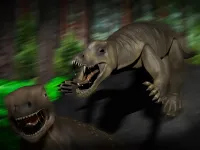INFORMATION:
Prehistoric killing machine exposed
Previously thought of as heavy, slow and sluggish, the 260-million-year-old predator, Anteosaurus, was a ferocious hunter-killer
2021-03-03
(Press-News.org) Judging by its massive, bone-crushing teeth, gigantic skull and powerful jaw, there is no doubt that the Anteosaurus, a premammalian reptile that roamed the African continent 265 to 260 million years ago - during a period known as the middle Permian - was a ferocious carnivore.
However, while it was previously thought that this beast of a creature - that grew to about the size of an adult hippo or rhino, and featuring a thick crocodilian tail - was too heavy and sluggish to be an effective hunter, a new study has shown that the Anteosaurus would have been able to outrun, track down and kill its prey effectively.
Despite its name and fierce appearance, Anteosaurus is not a dinosaur but rather belongs to the dinocephalians--mammal-like reptiles predating the dinosaurs. Much like the dinosaurs, dinocephalians roamed and ruled the Earth in the past, but they originated, thrived, and died about 30 million years before the first dinosaur even existed.
The fossilised bones of Dinocephalians are found in many places in the world. They stand out by their large size and heavy weight. Dinocephalian bones are thick and dense, and Anteosaurus is no exception. The Anteosaurus' skull was ornamented with large bosses (bumps and lumps) above the eyes and a long crest on top of the snout which, in addition to its enlarged canines, made its skull look like that of a ferocious creature. However, because of the heavy architecture of its skeleton, it was previously assumed that it was a rather sluggish, slow-moving animal, only capable of scavenging or ambushing its prey, at best.
"Some scientists even suggested that Anteosaurus was so heavy that it could only have lived in water," says Dr Julien Benoit of the Evolutionary Studies Institute at the University of the Witwatersrand (Wits University).
By carefully reconstructing the skull of the Anteosaurus digitally using X-ray imaging and 3D reconstructions, a team of researchers investigated the internal structures of the skull and found that the specific characteristics of its brain and balance organs were developed in such a way that it was everything but slow-moving.
"Agile predators such as cheetahs or the infamous Velociraptor have always had a very specialised nervous systems and fine-tuned sensory organs that enable them to track and hunt down prey effectively," says Benoit. "We wanted to find out whether the Anteosaurus possessed similar adaptations."
The team found that the organ of balance in Anteosaurus (its inner ear) was relatively larger than that of its closest relatives and other contemporaneous predators. This indicates that Anteosaurus was capable of moving much faster than its prey and competitors. They also found that the part of the brain responsible for coordinating the movements of the eyes with the head was exceptionally large, which would have been a crucial trait to ensure the animal's tracking abilities.
"In creating the most complete reconstruction of an Anteosaurus skull to date, we found that overall, the nervous system of Anteosaurus was optimised and specialised for hunting swiftly and striking fast, unlike what was previously believed," says Dr Ashley Kruger from the Natural History Museum in Stockholm, Sweden and previously from Wits University.
"Even though Anteosaurus lived 200-million years before the famous dinosaur Tyrannosaurus rex, Anteosaurus was definitely not a 'primitive' creature, and was nothing short of a mighty prehistoric killing machine," says Benoit.
ELSE PRESS RELEASES FROM THIS DATE:
How do you know where volcanic ash will end up?
2021-03-03
When the Eyjafjallajökull volcano in Iceland erupted in April 2010, air traffic was interrupted for six days and then disrupted until May. Until then, models from the nine Volcanic Ash Advisory Centres (VAACs) around the world, which aimed at predicting when the ash cloud interfered with aircraft routes, were based on the tracking of the clouds in the atmosphere. In the wake of this economic disaster for airlines, ash concentration thresholds were introduced in Europe which are used by the airline industry when making decisions on flight restrictions. However, a team of researchers, ...
Planetary science intern leads study of Martian crust
2021-03-03
The planet Mars has no global magnetic field, although scientists believe it did have one at some point in the past. Previous studies suggest that when Mars' global magnetic field was present, it was approximately the same strength as Earth's current field. Surprisingly, instruments from past Mars missions, both orbiters and landers, have spotted patches on the planet's surface that are strongly magnetized--a property that could not have been produced by a magnetic field similar to Earth's, assuming the rocks on both planets are similar.
Ahmed AlHantoobi, an intern working with Northern Arizona University planetary scientists, assistant professor Christopher Edwards and postdoctoral ...
Accelerating gains in abdominal fat during menopause tied to heart disease risk
2021-03-03
PITTSBURGH, March 3, 2021 - Women who experience an accelerated accumulation of abdominal fat during menopause are at greater risk of heart disease, even if their weight stays steady, according to a University of Pittsburgh Graduate School of Public Health-led analysis published today in the journal Menopause.
The study--based on a quarter century of data collected on hundreds of women--suggests that measuring waist circumference during preventive health care appointments for midlife women could be an early indicator of heart disease risk beyond the widely used body mass index (BMI)--which is a calculation of weight vs. height.
"We need to shift gears on how we think about heart disease risk in women, particularly as they approach and go through menopause," said senior ...
Study reveals frequency and characteristics of stroke in COVID-19 patients
2021-03-03
A review of nearly 28,000 emergency department records shows less than 2% of patients diagnosed with COVID-19 suffered an ischemic stroke but those who did had an increased risk of requiring long-term care after hospital discharge. Those are the findings from a study conducted by researchers from the University of Missouri School of Medicine and MU Health Care.
The researchers teamed up with the MU Institute for Data Science and Informatics and the Tiger Institute for Health Innovation to review data from 54 health care facilities. They found 103 patients (1.3%) developed ischemic stroke among 8,163 patients with COVID-19. ...
New York State's hospital nurse staffing legislation predicted to save lives and money
2021-03-03
PHILADELPHIA (March 3, 2021) - According to a new study published in Medical Care, improving hospital nurse staffing as proposed in pending legislation in New York state would likely save lives. The cost of improving nurse staffing would be offset by savings achieved by reducing hospital readmissions and length of hospital stays.
Researchers at the Center for Health Outcomes and Policy Research (CHOPR) at the University of Pennsylvania School of Nursing, conducted independent research in early 2020 on whether pending nurse staffing legislation in New York state is in the public's interest. The study of 116 hospitals and 418,000 Medicare patients documented large differences in patient-to-nurse ratios by hospital from an average of 4.3 patients for each nurse to as many ...
Utah researchers illuminate potential precursors of blood cancers
2021-03-03
SALT LAKE CITY - Utah researchers report significant new insights into the development of blood cancers. In work published today in Blood Cancer Discovery, a journal of the American Association for Cancer Research, scientists describe an analysis of published data from more than 7,000 patients diagnosed with leukemia and other blood disorders. Their findings provide new clues about mutations that may initiate cancer development and those that may help cancer to progress.
The researchers sought to identify mutation hotspots, or frequent changes ...
Serious new COVID-related smoking threat discovered by Ben-Gurion University researchers
2021-03-03
BEER-SHEVA, ISRAEL...March 3, 2021 - Ben-Gurion University of the Negev Researchers (BGU) have found for the first time that cigarette smoke toxicity impacts the protective biofilm in the lungs, particularly concerning when paired with COVID-19 respiratory issues.
Though many health factors are known about smoking, little is known about the overall toxicity potential of its ingredients. Researchers developed a new smoke testing system called a bacterial panel with genetically modified bioluminescent bacteria to measure both filtered and unfiltered cigarette smoke's complex molecular mixture.
According to the new study published in the journal Talanta, the researchers found that cigarette smoke affects communication between bacteria, which can affect microorganisms ...
Evolution drives autism and other conditions to occur much more frequently in boys
2021-03-03
HAMILTON, ON, March 3, 2021 -- Evolutionary forces drive a glaring gender imbalance in the occurrence of many health conditions, including autism, a team of genetics researchers has concluded.
The human genome has evolved to favour the inheritance of very different characteristics in males and females, which in turn makes men more vulnerable to a host of physical and mental health conditions, say the researchers responsible for a new paper published in the Journal of Molecular Evolution.
Their analysis shows that while there are certain conditions that occur only in women (cervical cancer and ovarian cancer, for example), or much more frequently in women (such as multiple sclerosis), men are more prone to medical conditions overall and, as a result, on average die sooner than ...
SARS-CoV-2 variant that emerged in UK more transmissible; could spark resurgences
2021-03-03
A variant of SARS-CoV-2 that emerged in southeast England in November 2020 is more transmissible than pre-existing variants, a new modeling study finds. Further analyses suggest the variant - VOC 202012/01 - will lead to large resurgences of COVID-19 cases. "Without stringent control measures, including limited closure of educational institutions and a greatly accelerated vaccine roll-out, COVID-19 hospitalizations and deaths across England in 2021 will exceed those in 2020," the study's authors say. After emerging in November 2020, evidence began to emerge ...
Molybdenum disulfide ushers in era of post-silicon photonics
2021-03-03
Researchers of the Center for Photonics and Two-Dimensional Materials at MIPT, together with their colleagues from Spain, Great Britain, Sweden, and Singapore, including co-creator of the world's first 2D material and Nobel laureate Konstantin Novoselov, have measured giant optical anisotropy in layered molybdenum disulfide crystals for the first time. The scientists suggest that such transition metal dichalcogenide crystals will replace silicon in photonics. Birefringence with a giant difference in refractive indices, characteristic of these substances, will make it possible to develop faster yet tiny optical devices. The work is published in the ...
LAST 30 PRESS RELEASES:
UCLA study links scar healing to dangerous placenta condition
CHANGE-seq-BE finds off-target changes in the genome from base editors
The Journal of Nuclear Medicine Ahead-of-Print Tip Sheet: January 2, 2026
Delayed or absent first dose of measles, mumps, and rubella vaccination
Trends in US preterm birth rates by household income and race and ethnicity
Study identifies potential biomarker linked to progression and brain inflammation in multiple sclerosis
Many mothers in Norway do not show up for postnatal check-ups
Researchers want to find out why quick clay is so unstable
Superradiant spins show teamwork at the quantum scale
Cleveland Clinic Research links tumor bacteria to immunotherapy resistance in head and neck cancer
First Editorial of 2026: Resisting AI slop
Joint ground- and space-based observations reveal Saturn-mass rogue planet
Inheritable genetic variant offers protection against blood cancer risk and progression
Pigs settled Pacific islands alongside early human voyagers
A Coral reef’s daily pulse reshapes microbes in surrounding waters
EAST Tokamak experiments exceed plasma density limit, offering new approach to fusion ignition
Groundbreaking discovery reveals Africa’s oldest cremation pyre and complex ritual practices
First breathing ‘lung-on-chip’ developed using genetically identical cells
How people moved pigs across the Pacific
Interaction of climate change and human activity and its impact on plant diversity in Qinghai-Tibet plateau
From addressing uncertainty to national strategy: an interpretation of Professor Lim Siong Guan’s views
Clinical trials on AI language model use in digestive healthcare
Scientists improve robotic visual–inertial trajectory localization accuracy using cross-modal interaction and selection techniques
Correlation between cancer cachexia and immune-related adverse events in HCC
Human adipose tissue: a new source for functional organoids
Metro lines double as freight highways during off-peak hours, Beijing study shows
Biomedical functions and applications of nanomaterials in tumor diagnosis and treatment: perspectives from ophthalmic oncology
3D imaging unveils how passivation improves perovskite solar cell performance
Enriching framework Al sites in 8-membered rings of Cu-SSZ-39 zeolite to enhance low-temperature ammonia selective catalytic reduction performance
AI-powered RNA drug development: a new frontier in therapeutics
[Press-News.org] Prehistoric killing machine exposedPreviously thought of as heavy, slow and sluggish, the 260-million-year-old predator, Anteosaurus, was a ferocious hunter-killer





